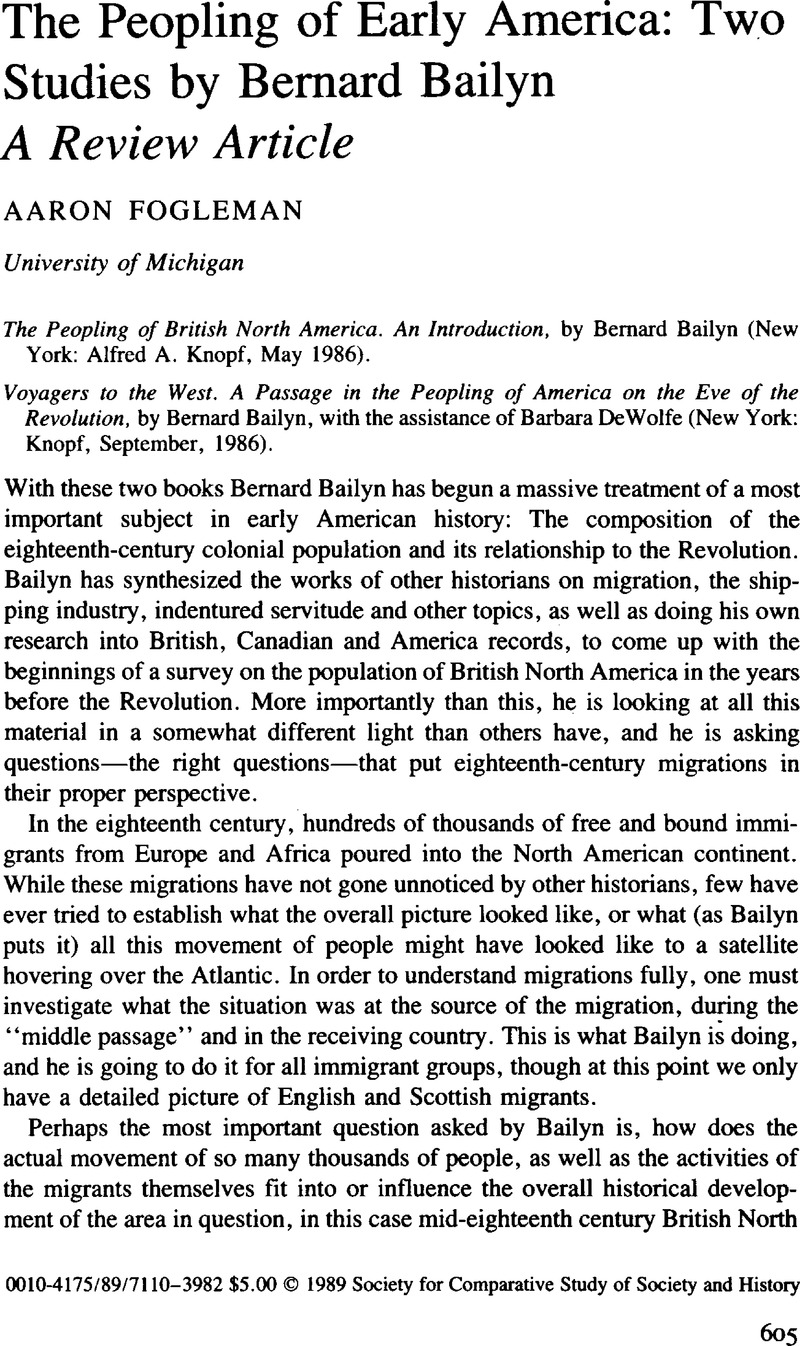No CrossRef data available.
Published online by Cambridge University Press: 03 June 2009

1 Bailyn gathered this information from the Register of Emigrants, 1773–1776—four large volumes maintained by the Treasury Office in London. John Pownall, undersecretary of state for the colonies, instigated this project in order to alleviate fears of Parliament regarding the large number of British inhabitants emigrating to the colonies. Pownall convinced Parliament that they should first ascertain the extent of the emigration before taking any measures against it. Only emigrants from England or Scotland are listed (Voyagers, pp. 67–70).
2 See p. 20 in Peopling. Although I agree that Bailyn is basically correct in this proposition, there is a problem with the evidence he presents in Voyagers to show how overseas migration was an extension of domestic mobility. He found evidence that for many, the trip, for example, from London to America was the second stage of a migration that may have begun from as far away as Scotland without the intention of leaving Britain. That is, many of those who went to America were practically nomads wandering around Britain who went to America because it seemed to be the best opportunity available at the time. This certainly happened, but only a minority of the 9.364 emigrants in the register Railvn used fit into this category (pp. 104ff).
3 See Braudel, Fernand, Capitalism and Material Life (1400–1800, New York, 1973), p. 59Google Scholar; and Fenske, Hans, “International Migration: Germany in the Eighteenth Century,” Central European History, 133 (12, 1980), 332–47.CrossRefGoogle Scholar
4 A possible critique of Bailyn at this point could be his lack of combining some of these factors into a multiple regression in order to better control the relationship of these factors with each other. Though he probably should have done this, his computer analysis and other evidence as it stands still goes a long way toward supporting his conclusions.
5 See Hippel, Wolfgang von, Auswanderung aus Sudwestdeutschland (Stuttgart, 1984)Google Scholar
6 See Curtin, Philip D., The Atlantic Slave Trade, A Census (Madison, 1969), Table 39, p. 137.Google Scholar
7 I have used the same source upon which Bailyn's figure for German immigration is based, i.e. the ship lists compiled by Strassburger, Ralph B. and Hinke, William J., Pennsylvania German Pioneers, 3 vols. (Norristown, PA, 1934)Google Scholar. Bailyn overestimated German immigration into Pennsylvania after 1760 by about 2,000. He used the average number of passengers per signature in the lists for the entire century (2.5) rather than for the years in question. However, there were approximately 1,000 Germans known to have immigrated through Charleston from 1763 to 1773, and they would bring the actual total up to 11,000. See Revill, Jane, ed., A Compilation of the Original Lists of Protestant Immigrants to South Carolina, 1763–1773 (Columbia, 1939).Google Scholar
8 I have no good figures for English or Scottish immigration. Bailyn's English figure is based upon a simple projection of the 1773–1776 total from the Register to the years 1764–1776 (at the same rate). This was done by Fingerhut, Eugene R., “Assimilation of Immigrants on the Frontier of New York, 1764–1776,” (Ph.D diss., Columbia University, 1962), p. 320Google Scholar. He claims this is a conservative figure. My Scottish figure is a very rough estimate based upon Meyer, Duane, The Highland Scots of North Carolina, 1732–1776 (Durham, NC, 1961), p. 3Google Scholar; and Bailyn's figure. My Scots-Irish figure comes from one of Bailyn's sources: Dickson, R. J., Ulster Emigration to Colonial America, 1718–1775 (London, 1966), p.59; and does not include non-Ulster emigrants.Google Scholar